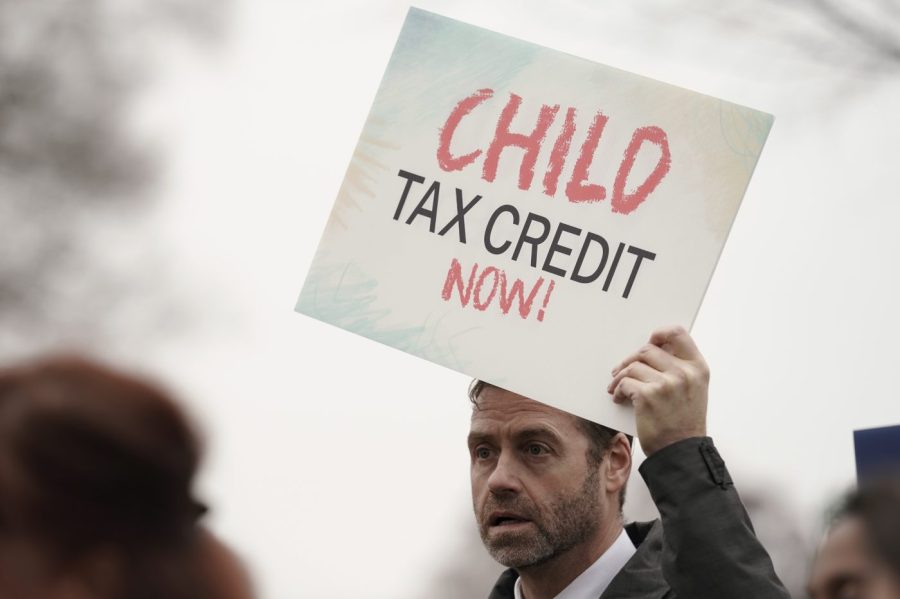Business
White House prepares for sharp rise in poverty rate on September 11, 2023 at 11:00 pm Business News | The Hill

The White House is preparing for a sharp rise in the U.S. poverty rate following the end of pandemic-era child tax credit (CTC) expansion.
President Biden and Democrats fought unsuccessfully last year to extend an expanded version of the CTC that started during the depths of the pandemic and temporarily lifted millions of children out of poverty.
The Census Bureau is set to release Tuesday its annual report on poverty, income, and health insurance. The new poverty data will be a hit for Biden, whose reelection campaign could hinge on how Americans feel about the economy.
The Council of Economic Advisers (CEA) said in a blog post Friday that it expects a “sharp rise” in the Supplemental Poverty Measure, which measures income and benefits plus government programs such as tax refunds and food stamps.
To “understand why this is likely to happen in 2022, it is crucial to remember what happened in 2021,” the CEA argued.
A Democratic-controlled Congress passed the beefed-up CTC in 2021, boosting the credit eligible parents could receive to $3,000 per child over the age of 6 and $3,600 per child under the age of 6.
The enhanced CTC alone lifted almost 3 million children out of poverty in 2021 and cut the child poverty rate by more than 40 percent in 2021, the CEA wrote.
The expansion expired in December 2021, and Democrats have not been able to strike a deal with Republicans to bring it back since.
Sen. Michael Bennet (D-Colo.), who has championed expanding the program, said that the census data will show that Congress should have not allowed the expanded credit to expire.
“When we expanded the Child Tax Credit, we demonstrated that we don’t have to accept one of the highest childhood poverty rates in the industrialized world as a permanent feature of our democracy. Tomorrow’s data will show we never should have let it expire, and I’m committed to doing everything I can to restore it,” he told The Hill in a statement.
The CEA argued Friday that the increase in poverty is likely to persist absent congressional action to restore the enhanced child tax credit.
Zach Moller, director of the economic program at the center-left think tank Third Way, said Democrats will uphold this report as a good reason to continue the child tax credit expansion because it’s proof that government intervention is necessary.
“The government can absolutely fight childhood poverty, it just costs money to do it,” he said. “Those policies that the Biden administration and the Congress were able to implement in the American Rescue Plan act were temporary, so the improvement in child poverty is temporary.”
Cutting child poverty for the long term has been a goal for Biden since he took office.
The expanded CTC was a centerpiece of Biden’s American Rescue Plan, the 2021 economic relief bill passed after Democrats took control of the White House and Congress.
Biden and fellow Democrats are eager to tout the benefits of the president’s economic plan, dubbed “Bidenomics,” with the 2024 election roughly a year away.
Republicans have blamed Biden for the surge in inflation that began shortly after he took office, though price growth sped up across the world in the wake of the pandemic.
Biden, meanwhile, has recently stepped up attacks on former President Trump about the economy while hoping to highlight the rapid recovery and the historically strong job market of his own presidency.
Biden and Democratic lawmakers have also touted trillions of dollars allocated for improving infrastructure, bringing down drug prices, expanding manufacturing and cracking down on tax evasion by the wealthy and corporations.
But messaging about the economy hasn’t been easy for the Biden administration; Bidenomics is a major talking point for the administration on the campaign trail but has yet to really take off with Americans.
A recent RealClearPolitics polling average shows just 38 percent of those surveyed approve of Biden’s handling of the economy, compared with 58.4 percent who disapprove.
Biden has been hit with dismal polling numbers overall lately. A CNN poll released last week found that 46 percent of registered voters said any Republican presidential nominee would be better than Biden in next year’s election and found his overall approval rating at a 39 percent.
Moller argued that Biden’s focus on creating jobs, especially for low-income Americans, could bring him closer to his goal of cutting child poverty because of provisions in his top legislative achievements — the Inflation Reduction Act, the infrastructure bill, and the CHIPs and Science Act.
“All that manufacturing is going to be incredibly helpful for folks with out there that don’t have a college degree. And so that is another way of trying to tackle childhood poverty, by making sure that parents have a good-paying job,” Moller said.
In its blog post, the CEA noted that the Congressional Budget Office projected in 2021 that it would take until the end of 2025 for the jobless rate to fall under 4 percent. The unemployment rate was 3.8 percent as of August, not far from its 3.5 percent rate before the pandemic.
Inflation is steadily improving, a success that the president touts often. But the CEA expects Tuesday’s census data to show inflation-adjusted income falling in 2022.
The agency blamed “elevated pandemic inflation” and “factors such as the Russian invasion of Ukraine and avian bird flu” for the 2022 data, and the Biden administration will likely argue that the data is in the rear-view because of the improvements in inflation in 2023.
Business, Administration The White House is preparing for a sharp rise in the U.S. poverty rate following the end of pandemic-era child tax credit (CTC) expansion. President Biden and Democrats fought unsuccessfully last year to extend an expanded version of the CTC that started during the depths of the pandemic and temporarily lifted millions of children out…
Business
Why 9 Million Americans Have Left

The Growing American Exodus
Nearly 9 million Americans now live outside the United States—a number that rivals the population of several states and signals a profound shift in how people view the American dream. This mass migration isn’t confined to retirees or the wealthy. Thanks to remote work, digital nomad visas, and mounting pressures at home, young professionals, families, and business owners are increasingly joining the ranks of expats.

Rising Costs and Shrinking Wallets
Living in the US has become increasingly expensive. Weekly grocery bills topping $300 are not uncommon, and everyday items like coffee and beef have surged in price over the last year. Rent, utilities, and other essentials also continue to climb, leaving many Americans to cut meals or put off purchases just to make ends meet. In contrast, life in countries like Mexico or Costa Rica often costs just 50–60% of what it does in the US—without sacrificing comfort or quality.
Health Care Concerns Drive Migration
America’s health care system is a major trigger for relocation. Despite the fact that the US spends more per person on health care than any other country, millions struggle to access affordable treatment. Over half of Americans admit to delaying medical care due to cost, with households earning below $40,000 seeing this rate jump to 63%. Many expats point to countries such as Spain or Thailand, where health care is both affordable and accessible, as a major draw.

Seeking Safety Abroad
Public safety issues—especially violent crime and gun-related incidents—have made many Americans feel unsafe, even in their own communities. The 2024 Global Peace Index documents a decline in North America’s safety ratings, while families in major cities often prioritize teaching their children to avoid gun violence over simple street safety. In many overseas destinations, newly arrived American families report a significant improvement in their sense of security and peace of mind.
Tax Burdens and Bureaucracy
US tax laws extend abroad, requiring expats to file annual returns and comply with complicated rules through acts such as FATCA. For some, the burden of global tax compliance is so great that thousands relinquish their US citizenship each year simply to escape the paperwork and scrutiny.
The Digital Nomad Revolution
Remote work has unlocked new pathways for Americans. Over a quarter of all paid workdays in the US are now fully remote, and more than 40 countries offer digital nomad visas for foreign professionals. Many Americans are leveraging this opportunity to maintain their US incomes while cutting costs and upgrading their quality of life abroad.

Conclusion: Redefining the Dream
The mass departure of nearly 9 million Americans reveals deep cracks in what was once considered the land of opportunity. Escalating costs, inaccessible healthcare, safety concerns, and relentless bureaucracy have spurred a global search for better options. For millions, the modern American dream is no longer tied to a white-picket fence, but found in newfound freedom beyond America’s borders.
Business
Will Theaters Crush Streaming in Hollywood’s Next Act?

Hollywood is bracing for a pivotal comeback, and for movie lovers, it’s the kind of shake-up that could redefine the very culture of cinema. With the freshly merged Paramount-Skydance shaking up its strategy, CEO David Ellison’s announcement doesn’t just signal a change—it reignites the passion for moviegoing that built the magic of Hollywood in the first place.

Theatrical Experience Roars Back
Fans and insiders alike have felt the itch for more event movies. For years, streaming promised endless options, but fragmented attention left many longing for communal spectacle. Now, with Paramount-Skydance tripling its film output for the big screen, it’s clear: studio leaders believe there’s no substitute for the lights, the hush before the opening credits, and the collective thrill of reacting to Hollywood’s latest blockbusters. Ellison’s pivot away from streaming exclusives taps deep into what unites cinephiles—the lived experience of cinema as art and event, not just content.
Industry Pulse: From Crisis to Renaissance
On the financial front, the numbers are as electrifying as any plot twist. After years of doubt, the box office is roaring. AMC, the world’s largest theater chain, reports a staggering 26% spike in moviegoer attendance and 36% revenue growth in Q2 2025. That kind of momentum hasn’t been seen since the heyday of summer tentpoles—and it’s not just about more tickets sold. AMC’s strategy—premium screens, with IMAX and Dolby Cinema, curated concessions, and branded collectibles—has turned every new release into an event, driving per-customer profits up nearly 50% compared to pre-pandemic norms.
Blockbusters Lead the Culture
Forget the gloom of endless streaming drops; when films like Top Gun: Maverick, Mission: Impossible, Minecraft, and surprise hits like Weapons and Freakier Friday draw crowds, the industry—and movie fans—sit up and take notice. Movie-themed collectibles and concession innovations, from Barbie’s iconic pink car popcorn holders to anniversary tie-ins, have made each screening a moment worth remembering, blending nostalgia and discovery. The focus: high-impact, shared audience experiences that streaming can’t replicate.
Streaming’s Limits and Studio Strategy
Yes, streaming is still surging, but the tide may be turning. The biggest franchises, and the biggest cultural events, happen when audiences come together for a theatrical release. Paramount-Skydance’s shift signals to rivals that premium storytelling and box office spectacle are again at the center of Hollywood value creation. The result is not just higher profits for exhibitors like AMC, but a rebirth of movie-going as the ultimate destination for fans hungry for connection and cinematic adventure.

Future Forecast: Culture, Community, and Blockbuster Dreams
As PwC and others warn that box office totals may take years to fully catch up, movie lovers and industry leaders alike are betting that exclusive theatrical runs, enhanced viewing experiences, and fan-driven engagement are the ingredients for long-term recovery—and a new golden age. The Paramount-Skydance play is more than a business move; it’s a rallying cry for the art of the theatrical event. Expect more big bets, more surprises, and—finally—a long-overdue renaissance for the silver screen.
For those who believe in the power of cinema, it’s a thrilling second act—and the best seat in the house might be front and center once again.
Business
Why Are Influencers Getting $7K to Post About Israel?

Influencers are being paid as much as $7,000 per post by the Israeli government as part of an expansive and sophisticated digital propaganda campaign. This effort is designed to influence global public opinion—especially among younger social media users—about Israel’s actions in Gaza and to counter critical narratives about the ongoing humanitarian situation.

How Much Is Being Spent?
Recent reports confirm that Israel has dedicated more than $40 million this year to social media and digital influence campaigns, targeting popular platforms such as TikTok, YouTube, and Instagram. In addition to direct influencer payments, Israel is investing tens of millions more in paid ads, search engine placements, and contracts with major tech companies like Google and Meta to push pro-Israel content and challenge critical coverage of issues like the famine in Gaza.
What’s the Strategy?
- Influencer Contracts: Influencers are recruited—often with all-expenses-paid trips to Israel, highly managed experiences, and direct payments—to post content that improves Israel’s image.
- Ad Campaigns: State-backed ad buys show lively Gaza markets and restaurants to counter global reports of famine and humanitarian crisis.
- Narrative Management: These posts and ads often avoid overt propaganda. Instead, they use personal stories, emotional appeals, and “behind the scenes” glimpses intended to humanize Israel’s side of the conflict and create doubt about reports by the UN and humanitarian agencies.
- Amplification: Paid content is strategically promoted so it dominates news feeds and is picked up by news aggregators, Wikipedia editors, and even AI systems that rely on “trusted” digital sources.
Why Is This Happening Now?
The humanitarian situation in Gaza has generated increasing international criticism, especially after the UN classified parts of Gaza as experiencing famine. In this environment, digital public relations has become a primary front in Israel’s efforts to defend its policies and limit diplomatic fallout. By investing in social media influencers, Israel is adapting old-school propaganda strategies (“Hasbara”) to the era of algorithms and youth-driven content.
Why Does It Matter?
This campaign represents a major blurring of the lines between paid promotion, journalism, and activism. When governments pay high-profile influencers to shape social media narratives, it becomes harder for audiences—especially young people—to distinguish between authentic perspectives and sponsored messaging.

In short: Influencers are getting $7,000 per post because Israel is prioritizing social media as a battleground for public opinion, investing millions in shaping what global audiences see, hear, and believe about Gaza and the conflict.

 Business4 weeks ago
Business4 weeks agoDisney Loses $3.87 Billion as Subscription Cancellations Surge After Kimmel Suspension

 Entertainment4 weeks ago
Entertainment4 weeks agoWhat the Deletion Frenzy Reveals in the David and Celeste Tragedy

 Entertainment4 weeks ago
Entertainment4 weeks agoExecutive Producer Debut: How Celia Carver Created Festival Hit ‘Afterparty’

 Health4 weeks ago
Health4 weeks agoRussia Claims 100% Success With New mRNA Cancer Vaccine

 Business3 weeks ago
Business3 weeks agoWhy Are Influencers Getting $7K to Post About Israel?

 Health4 weeks ago
Health4 weeks agoWhy Did Gen Z QUIT Drinking Alcohol?

 Advice4 weeks ago
Advice4 weeks agoHow AI Is Forcing Everyone Into the Entrepreneur Game

 Entertainment3 weeks ago
Entertainment3 weeks agoKeith Urban and Nicole Kidman Split After 20 Years as Actress Files for Divorce




























